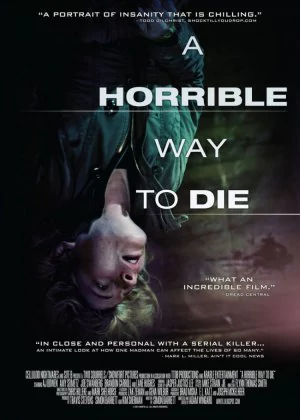A Horrible Way to Die

After being blown away by Pop Skull, director Adam Wingard became an instant favorite of mine. It's obvious the man has plenty of talent, so I was quite curious to see where it would lead him next. While A Horrible Way To Die was made directly after Pop Skull, the two films are actually very different and are almost impossible to compare. That's not to say A Horrible Way To Die isn't worth your attention though.

Pop Skull was above all an audiovisual experience, in A Horrible Way To Die Wingard finds a better balance between abstract atmospheres, proper character development and plot progression. Whether that actually results in a better film is something that greatly depends on your own take on cinema. The film is not as in your face as Pop Skull and takes a little longer to engage, but in the end there is still a clever pay-off and Wingard definitely succeeds in getting a clear point across.
With A Horrible Way To Die Wingard seems to be making his take on Henry (Portrait Of A Serial-Killer). The thematic similarities and low-budget background of both films are obvious enough, then again that's where the comparison between the both of them should probably end. Wingard makes a more subtle, introvert observation of the serial killer stereotype while clinging onto a rawer, darker edge the entire running time. Wingard's killer is not a depraved individual harboring pure evil, rather a helpless young man battling his uncontrollable urges.
Garrick Turrell is a notorious serial killer that was put behind bars when his girlfriend found out about his secret nightly activities. When Turrell is transferred between prisons though he sees an opportunity for escape and instinct takes over. On the other end of the spectrum we find Sarah, a young woman recovering from her drinking problems and reluctant to uphold any serious social contacts. The two are destined to meet, but things are never as clear or easy as they seem.

While Wingard turns the strobes, glitches and other funky visual trickery down a couple of notches, that's not to say that he completely ignores the film's visual impact, on the contrary. Wingard plays a lot with focus, keeps his camera close to his characters and operates it as if slightly drunk. The camera sways through the film, shifting focus all the time, sometimes completely losing track of the main characters only to find them again a couple of seconds later. Add to that some stellar play with lighting and color and you have a film that deserves to be applauded for its visual identity, even if it's not as outspoken as in Pop Skull.
The soundtrack too is familiar territory for Wingard. A smart mix of more traditional film music blended with dark drones and moody ambient make for the perfect ambiance and add an admirable level of dread and uneasiness to the reigning atmosphere. Again the score is not as sharp or overly present as it was in Pop Skull, but as the director clearly puts more focus on the story here, it's a perfectly understandable choice. In the end it still beats many other films out there who try to do similar things with drones and soundscapes.
AJ Bowen takes up the role of serial killer and does so with great conviction. He is perfect for a man living on the verge of society, struggling with his own natural urges which turn him into a ruthless killer when push comes to shove. Swanberg and Seimetz take up the roles of the supporting characters. They do a pretty decent job but remain somewhat overshadowed by the presence of Bowen. Especially Seimetz fights to uphold the strength of her character, who from time to time seems to wallows a little too much in her own sorrow.

The film has little regard for telling its story in chronological order. Wingard isn't helping much either by upholding a consistent style and hardly giving any indications or clues when time jumps occur. Clothes and hairdos are the biggest giveaways, but apart from that he leaves it up to the audience to figure out the details. I actually appreciated this extra level of vagueness as it kept the story (which is rather basic) interesting throughout. People who want to know what's going at all times should know that all things are properly explained during the course of the film, but mind that you could still feel considerably lost in several individual scenes.
I still need to see Home Sick and You're Next, but it seems that Wingard is using his talent for horror to create films that transcend simple genre cinema. Both Pop Skull and A Horrible Way To Die definitely deserve their horror classification, but only as a secondary genre. Don't expect an average slasher or simple serial killer flick here, Wingard aims higher and succeeds remarkably well on both accounts. It's good to know that there are some talented people out there dedicated to making a little more out of the horror genre than simple genre fare and fanservice products.
Even though similarities between this film and Pop Skull are rather slim, there's still an underlying signature style that clearly belongs to Wingard. His films are intimate, raw and combine a solid sense of realism with strong and outspoken styling. A Horrible Way To Die turned out to be a classy, gritty and nuanced serial killer flick that deserves a loving, appreciative audience. What side of Wingard you like best is mostly dependent on your own feelings of what good cinema is supposed to be, but if you like your films a little different there should be more than enough here to deliver an enjoyable and powerful evening worth of serial killer material.